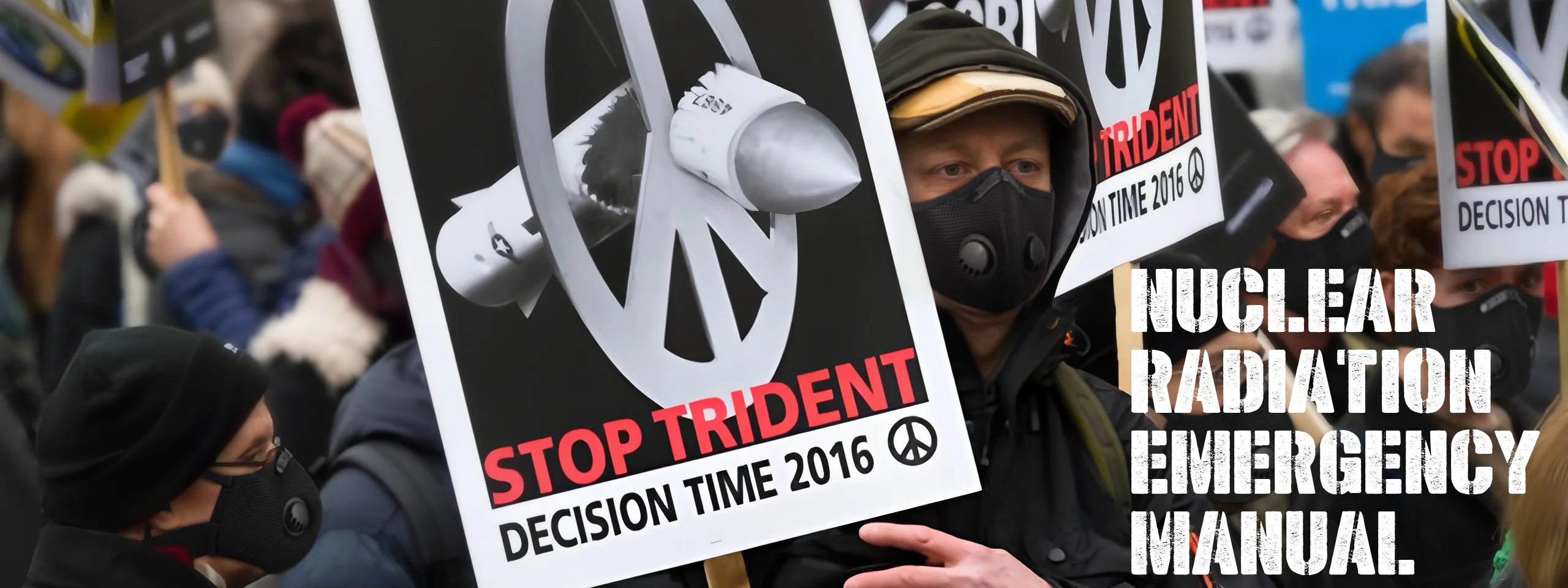Ketika menghadapi keadaan darurat nuklir, persiapan yang menyeluruh dan pengambilan keputusan yang tenang adalah pertahanan terbaik Anda. Meskipun bencana nuklir jarang terjadi, memiliki rencana yang matang dapat menjadi krusial untuk keselamatan Anda dan keluarga. Kami berharap informasi ini tidak akan pernah diperlukan—tetapi kami percaya bahwa ini adalah tanggung jawab kami untuk meningkatkan kesadaran tentang potensi ancaman dan memberikan panduan praktis.
Panduan langkah demi langkah ini akan membimbing Anda melalui cara mempersiapkan diri untuk keadaan darurat radiasi nuklir dan persediaan apa yang harus dikumpulkan. Setiap bagian menjelaskan apa yang harus dilakukan, mengapa itu penting, dan apa yang Anda butuhkan—berdasarkan ilmu pengetahuan yang terpercaya, bukan rasa takut. Mari kita mulai.
Langkah 1: Tetap Terinformasi dan Buat Rencana Darurat
Apa yang Harus Dilakukan:
-
Berlangganan sistem peringatan lokal atau aplikasi darurat.
-
Simpan radio bertenaga baterai atau radio dengan engkol tangan untuk pembaruan.
-
Siapkan rencana darurat keluarga dengan titik pertemuan dan kontak cadangan.
-
Persiapkan untuk kedua berlindung di tempat dan evakuasi skenario.
Mengapa Ini Penting:
Dalam keadaan darurat nuklir, setiap detik sangat berharga. Panduan dari pemerintah sering kali adalah: “Masuklah ke dalam. Tetaplah di dalam. Tetaplah mendengarkan.” Peringatan dini dan rencana yang jelas membantu mengurangi kepanikan dan membimbing tindakan aman serta cepat—bahkan jika komunikasi terputus.
Apa yang Anda Butuhkan:
-
Radio darurat bertenaga baterai atau dengan engkol tangan
-
Daftar kontak darurat (termasuk kontak luar kota)
-
Aplikasi peringatan lokal (FEMA, Palang Merah, dll.)
-
Rencana darurat keluarga yang dicetak
Langkah 2: Pilih Tempat Berlindung Dalam Ruangan yang Aman
Apa yang Harus Dilakukan:
-
Pilih sebuah ruangan interior tanpa jendela, lebih disukai ruang bawah tanah.
-
Letakkan sebanyak mungkin penghalang (dinding, lantai) antara Anda dan luar.
-
Persiapkan pita perekat dan lembaran plastik tebal untuk menutup pintu/jendela/ventilasi.
-
Bawa hewan peliharaan di dalam bersama Anda.
Mengapa Ini Penting:
Setelah ledakan, ancaman terbesar adalah fallout radioaktif—partikel-partikel kecil yang memancarkan radiasi dan hanyut bersama angin. Tetap tinggal di dalam, terutama di ruangan yang tertutup rapat, mengurangi paparan radiasi hingga hingga 90%.
Apa yang Anda Butuhkan:
-
Lembaran plastik tebal & pita perekat
-
Handuk/kain untuk menutup celah
-
Kipas bertenaga baterai atau pembersih udara HEPA (opsional)
-
Barang kenyamanan (selimut, perlengkapan hewan peliharaan, sleeping bag)
Langkah 3: Rakit Kit Pasokan Darurat
Apa yang Harus Dilakukan:
-
Persiapkan untuk setidaknya 3 hari, idealnya 2 minggu.
-
Simpan air minum dalam kemasan tertutup: 1 galon per orang per hari.
-
Termasuk makanan non-perishable, pembuka kaleng manual, senter, baterai.
-
Yang paling penting: tambahkan masker debu reusable dengan filtrasi tinggi, seperti Masker Debu BASE CAMP®.
Mengapa Ini Penting:
Utilitas dan toko mungkin ditutup. Memiliki kit perlindungan radiasi nuklir siap memungkinkan Anda tetap di dalam rumah dan menghindari paparan.
Apa yang Anda Butuhkan:
-
Air (persediaan untuk 3+ hari)
-
Makanan non-perishable (kaleng, batangan) + pembuka manual
-
Masker debu dengan filtrasi tinggi (misalnya, BASE CAMP® untuk perlindungan dari radiasi nuklir)
-
Senter & baterai
-
Radio bertenaga tangan atau baterai
-
Kotak P3K & obat-obatan
-
Barang kebersihan (sanitizer, tisu basah)
-
Pakaian ganti, sepatu kokoh
-
Kantong sampah (untuk pakaian yang terkontaminasi)
-
Salinan ID, uang tunai, power bank
Langkah 4: Persiapkan Peralatan Pelindung
Apa yang Harus Dilakukan:
-
Stok peralatan pelindung untuk setiap anggota keluarga:
-
Masker debu reusable (setara N95 atau lebih baik)
-
Kacamata pengaman
-
Sarung tangan sekali pakai
-
Coverall penutup seluruh tubuh atau pakaian berlengan panjang
-
-
Simpan kalium iodida (KI) tablet untuk melindungi tiroid Anda.
-
Jika memungkinkan, beli Geiger counter (untuk teknisi perlindungan radiasi-pengukuran tingkat radiasi).
Mengapa Ini Penting:
Serpihan radioaktif dapat membakar kulit, merusak mata, dan membahayakan organ internal. Menghirup adalah yang paling berbahaya. pakaian pelindung nuklir (atau penutupan darurat) ditambah Masker Debu BASE CAMP® dapat melindungi dari serpihan radioaktif.
Kalium iodida membantu memblokir penyerapan iodin radioaktif oleh kelenjar tiroid, sangat penting untuk anak-anak.
✅ Berapa banyak kalium iodida yang harus diminum untuk perlindungan radiasi?
Ikuti instruksi otoritas kesehatan resmi. Dewasa: 130mg; Anak-anak: dosis lebih rendah berdasarkan berat/umur.
Apa yang Anda Butuhkan:
-
Penyaringan tinggi Masker Debu BASE CAMP®
-
Kacamata pengaman
-
Sarung tangan + lengan panjang / baju terusan (pakaian pelindung radiasi)
-
Tablet kalium iodida (KI)
-
Penghitung Geiger portabel (opsional tapi berguna)
Langkah 5: Selama Serpihan – Berlindung di Tempat
Apa yang Harus Dilakukan:
-
Pergi ke tempat berlindung yang ditentukan segera.
-
Segel jendela, pintu, ventilasi.
-
Matikan sistem HVAC/udara.
-
Tetap di dalam setidaknya 24 jam.
-
Pantau pembaruan menggunakan radio darurat.
Jika Anda harus keluar: kenakan masker debu Anda, kacamata pelindung, dan tutupi seluruh tubuh Anda.
Mengapa Ini Penting:
Beberapa jam pertama setelah detonasi adalah yang paling berbahaya. Serpihan paling berat terjadi segera, tetapi intensitas radiasi berkurang setengahnya setiap 7 jam. Tetap berlindung mengurangi paparan Anda terhadap dosis yang bisa mematikan.
Apa yang Anda Butuhkan:
-
Radio darurat
-
Bahan penyegelan (plastik & lakban)
-
Masker Debu BASE CAMP® untuk semua anggota rumah tangga
-
Lentera / senter
-
Makanan & air darurat (48+ jam)
-
Toilet darurat / ember dengan liner
Langkah 6: Setelah Serpihan – Decontaminasi dan Pemulihan
Apa yang Harus Dilakukan:
-
Ketika pejabat mengatakan aman—atau setelah 24+ jam—tinggalkan tempat perlindungan dengan hati-hati.
-
Tetap kenakan masker + perlengkapan pelindung.
-
Lepaskan pakaian luar—ini menghilangkan 90% debu serpihan.
-
Masukkan ke dalam kantong plastik tertutup, jauh dari area tinggal Anda.
-
Cuci kulit dan rambut yang terpapar dengan sabun dan air hangat.
-
Disinfeksi semua barang atau wadah luar ruangan.
-
Terus ikuti panduan resmi tentang makanan, air, dan kesehatan.
Mengapa Ini Penting:
Bahkan setelah jatuhnya awal, debu bisa tetap ada. Dekontaminasi yang tepat mencegah paparan internal dan melindungi orang lain. Melepas lapisan luar dan mencuci itu sederhana, tetapi penyelamat hidup.
Apa yang Anda Butuhkan:
-
Sabun, sampo, air
-
Handuk / tisu basah (jika tidak ada shower)
-
Pakaian bersih
-
Kantong plastik untuk pembuangan
-
Sarung tangan, masker
-
Tempat sampah disimpan jauh dari area hunian
✅ Kesimpulan: Bersiaplah, Jangan Takut
Mempersiapkan diri untuk darurat nuklir bukan berarti hidup dalam ketakutan—itu berarti mengambil kendali. Sama seperti menyimpan alat pemadam api atau sabuk pengaman, ini tentang kesiapan.
Dengan memahami bagaimana pakaian pelindung radiasi, masker debu, kalium iodida, dan perencanaan darurat bekerja sama, Anda memberikan diri Anda dan keluarga kesempatan terbaik untuk tetap aman.
Tetap terinformasi.
Simpan BASE CAMP® Dust Mask Anda siap digunakan.
Siapkan kit darurat yang cerdas.
Ketahui apa yang harus dilakukan dan mengapa.
Kesiapsiagaan bukan kepanikan—ini adalah ketenangan pikiran.
Tetap siap. Tetap aman. Bernapas dengan aman—setiap hari.



Membagikan:
Cara Memilih Masker Debu yang Tepat untuk Proyek Pengerjaan Kayu
Masker N95: Apa yang Perlu Anda Ketahui (Dan Mengapa Tidak Selalu Menjadi Pilihan Terbaik Anda)